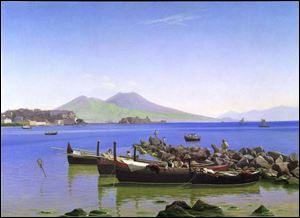
Pompeii's mysteries explored at Toledo museum
10/19/2006
The Bay of Naples, by Christen Schiellerup Kobke, is part of the exhibit The Lure of Pompeii.
We're fascinated with the Italian city that was frozen in time almost 2,000 years ago.
It's not unlike the lurid pleasure of imagining the lost city of Atlantis or the doomed Titanic, or watching a sci-fi thriller in which a family driving down a deserted highway is abducted by aliens.
Ever since a farmer discovered traces of Pompeii in the 1750s, it has attracted the curious, including the German poet Goethe, Mark Twain, and even Toledo Museum of Art founders Florence and Edward Libbey.
"From the 18th century on, for people who went on the Grand Tour of Europe, Naples and Pompeii were always on that tour," said Carolyn Putney, the museum's director of collections. "We thought we'd talk about what people most associate with Pompeii."
"The Lure of Pompeii," along with "The End: Mortality and Remembrance," are exhibits that open tomorrow at the Toledo Museum of Art. Both are created by museum staff as complements to "In Stabiano: Exploring the Ancient Seaside Villas of the Roman Elite," a ticketed show opening Nov. 11 that will feature 70 frescoes, statues, and household items from a wealthy resort town buried in ash and pumice by Mount Vesuvius in the year 79.
The Pompeii exhibit, in Gallery 18, displays about 50 objects, including photographs, paintings, and reproductions (but no originals) of items that were found in the ancient town: beautifully detailed bronze statues of a fawn and of the goddess Isis, a marble table and a small fountain, both reproductions made by the Chiurazzi Brothers in Italy. The fountain was a gift of Mrs. Libbey in 1925, said Putney, who has visited Pompeii many times.
A charmer is the 1759 painting, Allegory of Spring, by Spaniard Francesco de Mura, inspired by Pompeii's discovery. In it, young women dance and cherubs levitate as a volcano spews in the background.
And, there's a book published by Capt. William Hamilton, an enthusiastic collector of Roman, Greek and Etruscan antiquities and a British ambassador. For his 1767 book, he commissioned engravings of his prized objects, including a well-known Pompeiian vase that appears on the dedication page.
Also opening tomorrow, and fitting for the Halloween season, the Day of the Dead, and All Souls Day, is "The End," assembled from the museum's 20,000 works on paper by Thomas Loeffler, who reviews the entire collection periodically as manager for that department.
"It's about how we commemorate those who have departed," said Loeffler. "It's not a morbid show. It's about how we remember." The 100 rubbings, etchings, drawings, and photographs fill the Print Galleries on the lower level.
It is, in part, a stroll through a colonial cemetery. A never-before-seen (in Toledo) portfolio of about 45 tombstone rubbings of markers for early American pioneers was purchased in the 1960s by former museum director Otto Wittmann. Rubbed in greens and browns, most of the images depict only the decorative top portion of the grave markers, featuring stick-figure-like creatures such as skeletons and flying angels.
"We're transcribing epitaphs of who was buried under there. One family lost 13 children before they were two years old," noted Loeffler.
There are Japanese prints with fireflies that represent departed souls, and crows that are portents of death; photos of pyramids and sarcophagus.
And there's a small photograph with a ghoulish story to tell of the Capuchin monastery in Italy that Mark Twain visited in 1867. For hundreds of years, the skeletons of 4,000 deceased monks were unearthed and their bones were fashioned into decorations by living monks. Wrote Twain in his 1869 The Innocents Abroad:
"There were shapely arches, built wholly of thighbones; there were startling pyramids, built wholly of grinning skulls; there were quaint architectural structures of various kinds, built of shinbones and the bones of the arm; on the wall were elaborate frescoes, whose curving vines were made of knotted human vertebrae, whose delicate tendrils were made of sinews and tendons, whose flowers were formed of kneecaps and toenails."
"Lure of Pompeii" and "The End: Mortality & Remembrance," open tomorrow in two galleries at the Toledo Museum of Art. The former exhibit continues through Jan. 14, the latter through Jan. 21. Both are free. Hours are 10 a.m. to 4 p.m. Tuesday through Thursday and Saturday; 10 a.m. to 10 p.m. Friday, and 11 a.m. to 5 p.m. Sunday. Closed Mondays and major holidays. The museum is at 2445 Monroe St. Information: 419-255-8000 or www.toledomuseum.org.
Contact Tahree Lane at:
tlane@theblade.com
or 419-724-6075